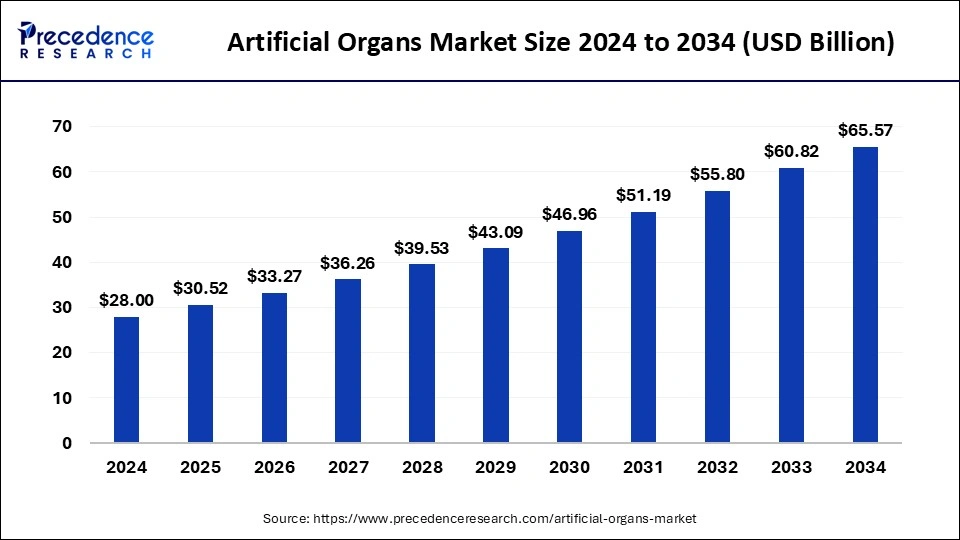The global artificial organs market size reached USD 25.69 billion in 2023 and is predicted to grow around USD 60.82 billion by 2033, growing at a CAGR of 9% from 2024 to 2033.
Key Points
- North America held the largest market share of 37% in 2023.
- Europe is expected to gain a significant market share during the forecast period.
- By organ type, the liver segment is expected to hold a significant market share over the forecast period.
- By organ type, the kidney segment is expected to grow at a notable rate in the upcoming years.
- By material type, the silicon segment dominated the artificial organs market in 2023.
- By material type, in 2023, the plastic segment was estimated to hold a significant market share.

The artificial organs market has witnessed substantial growth in recent years, driven by advancements in medical technology, increasing prevalence of organ failure, and a growing demand for organ transplantation. Artificial organs, also known as prosthetic organs or organoids, are engineered devices designed to replace the function of natural organs in the human body. These devices are typically made from biocompatible materials and are capable of performing specific functions such as filtration (as in artificial kidneys), pumping (as in artificial hearts), or insulin secretion (as in artificial pancreases).
The market for artificial organs is diverse, encompassing a wide range of organs including the heart, kidneys, liver, pancreas, lungs, and more. With the rise in chronic diseases such as cardiovascular disorders, renal failure, and diabetes, the demand for artificial organs continues to grow. Additionally, technological advancements in materials science, bioengineering, and 3D printing have significantly improved the design, functionality, and compatibility of artificial organs, further driving market growth.
Growth Factors:
Several factors contribute to the growth of the artificial organs market. One of the primary drivers is the increasing prevalence of chronic diseases leading to organ failure. Conditions such as heart disease, kidney disease, liver failure, and diabetes are on the rise globally, creating a growing pool of patients in need of organ transplantation or alternative treatment options.
Moreover, advancements in medical technology, including tissue engineering, regenerative medicine, and biofabrication techniques, have revolutionized the field of artificial organs. These innovations have enabled the development of more sophisticated and biocompatible prosthetic organs with improved functionality and longevity. Additionally, the growing acceptance and adoption of organ transplantation as a standard treatment modality for end-stage organ failure have fueled market growth.
Region Insights:
The artificial organs market exhibits regional variations in terms of demand, adoption rates, and regulatory frameworks. North America dominates the market, driven by the presence of well-established healthcare infrastructure, high healthcare expenditure, and a large patient population suffering from chronic diseases. The region is also characterized by a robust research and development ecosystem, with many leading medical device companies and academic institutions actively involved in artificial organ research.
Europe is another significant market for artificial organs, supported by favorable government initiatives, increasing investments in healthcare, and a growing aging population. Countries such as Germany, the UK, and France are at the forefront of artificial organ development and adoption in the region.
Asia Pacific is expected to witness rapid growth in the artificial organs market due to improving healthcare infrastructure, rising disposable incomes, and increasing awareness about advanced medical treatments. Countries like China, Japan, and India are investing heavily in healthcare infrastructure and research, driving market expansion in the region.
Artificial Organs Market Scope
| Report Coverage | Details |
| Growth Rate from 2024 to 2033 | CAGR of 9% |
| Global Market Size in 2023 | USD 25.69 Billion |
| Global Market Size by 2033 | USD 60.82 Billion |
| U.S. Market Size in 2023 | USD 6.65 Billion |
| U.S. Market Size by 2033 | USD 15.75 Billion |
| Base Year | 2023 |
| Forecast Period | 2024 to 2033 |
| Segments Covered | By Organ Type and By Material Type |
| Regions Covered | North America, Europe, Asia-Pacific, Latin America, and Middle East & Africa |
Artificial Organs Market Dynamics
Drivers:
Several key drivers are driving the growth of the artificial organs market. One of the primary drivers is the persistent shortage of donor organs for transplantation. Despite efforts to increase organ donation rates, there remains a significant gap between the supply and demand for donor organs globally. This shortage has led to the development of artificial organs as a viable alternative to transplantation, offering patients a life-saving treatment option without relying on scarce donor organs.
Furthermore, the aging population and the associated increase in age-related diseases have contributed to the growing demand for artificial organs. As people live longer, the incidence of chronic diseases such as heart disease, kidney failure, and diabetes rises, leading to a greater need for organ replacement therapies.
Technological advancements have also played a crucial role in driving market growth. Innovations in materials science, bioengineering, and medical imaging have led to the development of more advanced and durable artificial organs with enhanced functionality and compatibility. Additionally, the advent of 3D printing technology has revolutionized the manufacturing process, allowing for the production of custom-designed artificial organs tailored to individual patient needs.
Opportunities:
The artificial organs market presents several opportunities for growth and innovation. One such opportunity lies in the development of bioartificial organs, which combine biological components with synthetic materials to create hybrid devices that mimic the structure and function of natural organs more closely. Bioartificial organs have the potential to overcome many of the limitations of traditional prosthetic organs, including immune rejection and limited lifespan.
Another opportunity lies in expanding the application of artificial organs beyond traditional organ replacement therapies. For example, artificial organs could be used as temporary bridges to transplantation, providing life-saving support to patients awaiting donor organs. Additionally, artificial organs could be employed in regenerative medicine approaches, where they serve as scaffolds or templates to promote tissue regeneration and repair.
Furthermore, there is a growing trend towards miniaturization and implantable devices in the field of artificial organs, opening up new opportunities for minimally invasive treatment options and improved patient outcomes. Miniaturized artificial organs could be implanted directly into the body, reducing the need for external devices and enhancing patient mobility and quality of life.
Challenges:
Despite the promising growth prospects, the artificial organs market faces several challenges that must be addressed to realize its full potential. One of the primary challenges is the complex regulatory landscape governing medical devices and biologics, which can significantly impact the development, approval, and commercialization of artificial organs. Navigating the regulatory pathways for novel medical technologies requires substantial time, resources, and expertise, posing a barrier to entry for smaller companies and startups.
Another challenge is the high cost associated with artificial organs, which can limit access for patients, particularly in developing countries with limited healthcare resources. The cost of artificial organs includes not only the initial device itself but also ongoing maintenance, monitoring, and potential complications requiring additional medical intervention.
Moreover, ensuring the long-term safety and efficacy of artificial organs remains a significant challenge. While advancements in materials science and bioengineering have improved the biocompatibility and functionality of artificial organs, long-term studies are needed to assess their performance and durability in real-world clinical settings. Additionally, minimizing the risk of immune rejection and infection associated with artificial organs remains a key area of research and development.
Read Also: Dental CAD/CAM Market Size to Reach USD 6.87 Billion by 2033
Recent Developments
- In February 2024, the French medical technology company Carmat introduced a new software upgrade for its artificial heart, Aeson. With this update, the software of the artificial heart can identify potential malfunctions in real time and make necessary adjustments to ensure uninterrupted support for the patient.
- In May 2023, Indegene announced an expansion of its partnership with ConTIPI Medical, a provider of non-surgical solutions for women with pelvic floor dysfunctions. Together, they plan to introduce a new device to the market.
- In February 2022, Vanderbilt University Medical Center, Carnegie Mellon University, and Cornell University were awarded a four-year grant of USD 87 million from the Department of Defense Congressionally Directed Medical Research Program (CDMRP). The funding aimed to support the development of an artificial lung platform.
- In January 2022, the School of Medical Research and Technology (SMRT) at IIT Kanpur launched a program called Hridyantra. This program uses a grand challenge-based approach to develop an advanced artificial heart or a left ventricular assist device (LVAD).
Artificial Organs Market Companies
- ABIOMED
- Berlin Heart
- Zimmer Biomet
- Boston Scientific Corporation
- Cochlear Ltd.
- Edwards Lifesciences Corporation
- Ekso Bionics
- Medtronic
- Jarvik Heart, Inc
- SynCardia Systems, LLC
Segments Covered in the Report
By Organ Type
- Artificial Kidney
- Artificial Liver
- Artificial Lungs
- Artificial Pancreas
- Artificial Heart
- Others
By Material Type
- Silicon
- Plastic
- Steel
- Others
By Geography
- North America
- Europe
- Asia-Pacific
- Latin America
- Middle East and Africa
Contact Us:
Mr. Alex
Sales Manager
Call: +1 9197 992 333
Email: sales@precedenceresearch.com
Web: https://www.precedenceresearch.com
Blog: https://www.expresswebwire.com/
Blog: https://www.uswebwire.com/
